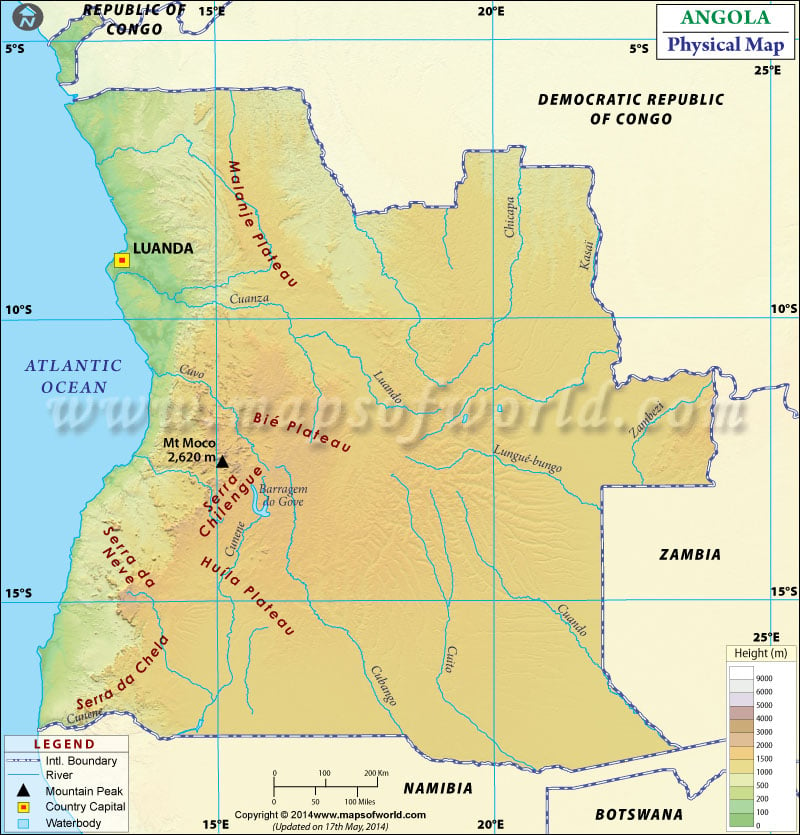- Neighboring Countries - Namibia, Zambia, Democratic Republic of the Congo, Botswana, Republic of the Congo
- Continent And Regions - Africa Map
- Other Angola Maps - Angola Map, Where is Angola, Angola Blank Map, Angola Road Map, Angola Rail Map, Angola River Map, Angola Cities Map, Angola Political Map, Angola Flag
It is located in the southern part of the continent of Africa on the western Atlantic Coast between Namibia and the Republic of Congo. The country also shares boundaries with the Democratic Republic of the Congo and Zambia to the east.
Physical Features of Angola
The physical map of Angola elaborates on elevations, plateaus, water bodies, mountain peaks, plains, and other topographic features in detail. This map explains the geography and trends in the height of Angola. Latitudes and Longitudes can also be seen.
The country’s total land area is 1,246,700 km2 (481,400 sq mi). Angola also has an exclusive economic zone of 518,433 km2 (200,168 sq miles). Angola can be categorized into the following natural regions:
The arid coastal lowland
The region stretches from Namibia to Luanda and has low plains and terraces. The coast is mostly flat with occasional low cliffs and bluffs of red sandstone. There is one deep inlet of the sea known as Great Fish Bay. Far north, there are Little Fish Bay, Port Alexander, and Lobito Bay, along with other shallower bays. The coastal lowland has risen from the sea in a sequence of low terraces. The region has different widths ranging from 25 kilometers (16 miles) near Benguela to more than 150 kilometers (93 mi) in the Cuanza River Valley south of Luanda.
Angola Mountains Ranges
This region is marked by a series of irregular escarpments and cuestas running parallel to the coast, about 20 to 100 kilometers inland. The north Cuanza river hills rise from the coastal zone to an average elevation of 500 meters (1,600 ft). In the southern part, hills rise sharply from the coastal lowlands forming a high escarpment. These extend from a point east of Luanda and run south through Namibia. The highest peak Mount Moco (2,620 m or 8 600 ft), can also be seen on the map.
High plateaus in Angola
The area lying east of the hills and mountains is a high plateau with an altitude of about 1,200 to 1,800 m (3,900 to 5,900 ft) on average. This region dominates most of Angola’s terrain. The surface of the plateau is mostly flat and rolling, but the parts of the Hufla plateau (Humpta Highland) and Benguela Plateau in the south have heights of 2,500 meters (8,200 ft) and more. The Malanjr plateau in the north has an average elevation of 1000 m (3,300 ft).
Rainforest in Angola
The rainforests of Angola are located in the north of the country and Cabinda. They are most threatened by subsistence agriculture. Overgrazing and cutting forests for fuel and wood are also significant causes of forest clearing and degradation in the region.
Principal Rivers in Angola
The two major rivers which are flowing through the country are the Zambezi and Congo, with Congo being the longest in the country. There are also several tributaries of the Congo River flowing through Angola. Other rivers of importance include Cuanza and the Cunene, with Cuanza flowing north and the Cunene flowing south before turning west. The Cuanza river is one of the navigable rivers in Angola for nearly 200 kilometers with commercial and military boats of significant size, another navigable river in Congo.

 Angola Facts
Angola Facts